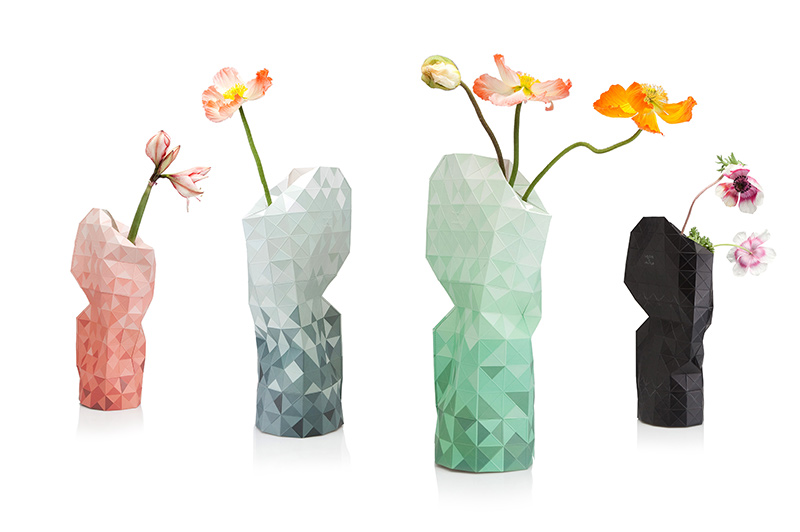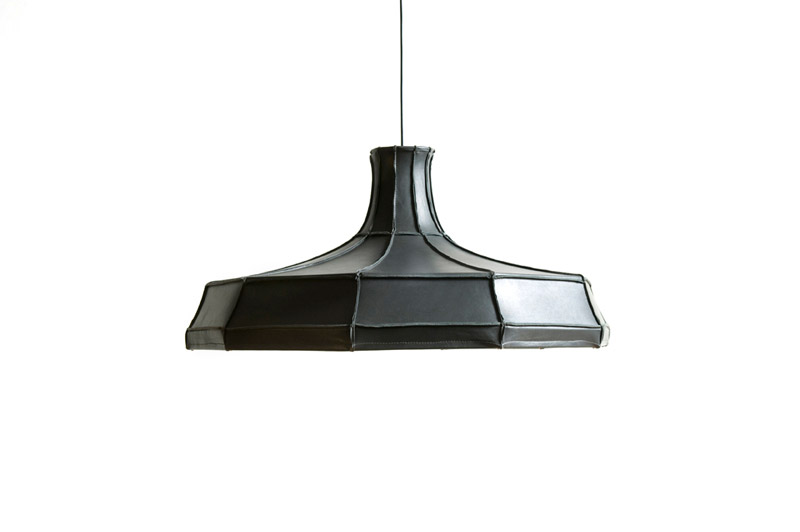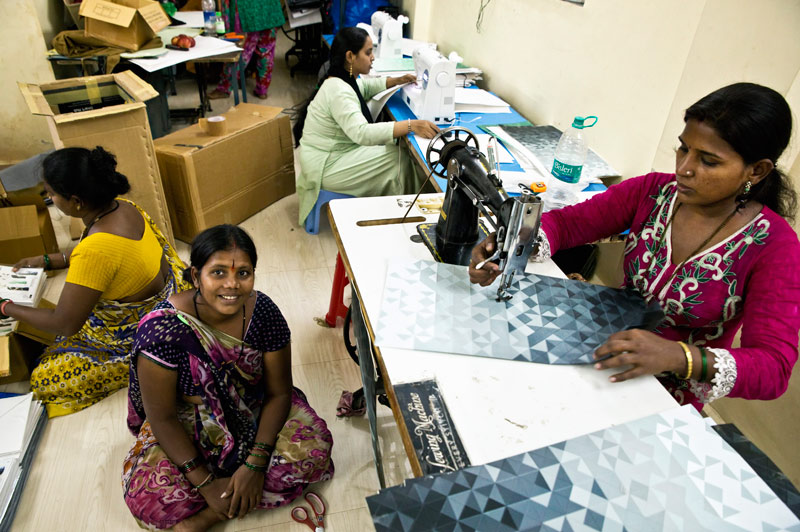Pepe Heykoop for Tiny Miracles – It is extremely satisfying to see what can be achieved with little more than a piece of folded paper.
Design Academy Eindhoven graduate Pepe Heykoop first reached an international audience when his flexible chair project, A Restless Chairacter, won the D3 award at IMM Cologne 2009, since then Pepe has gone on to achieve critical acclaim with projects such as the Chaos Chandelier, the Brick Series and the Skin Collection. And through his work for the Tiny Miracles Foundation. Established in 2010 by Pepe’s cousin Laurien Meuter, the Tiny Miracles Foundation works with an impoverished inner-city community in Mumbai, India, and has set itself the goal of helping the community move from “very poor” to “self supporting” by 2020. To this end Pepe has created a number of objects including the Leather Lampshades, Matka Vase, Paper Vase Covers and Folded Lampshade which are produced by the women in the community and distributed globally. Thus the Tiny Miracles Foundation not only provides work for the community, but the income generated enables both the children to attend school and the adults to attend workshops on subjects such as banking, hygiene and personal security.
To find out more about Tiny Miracles, what a Design Academy Eindhoven graduate can bring to the streets of Mumbai, and what the streets of Mumbai can teach a Design Academy Eindhoven graduate, we met up with Pepe Heykoop in Amsterdam, but started by asking, why design?
Pepe Heykoop: My final year project at high school involved designing a bridge, but rather than just calculate the forces and write a paper as the school wanted, I built a model to test and demonstrate the theory, to prove as it were that my plan worked and not just that I could remember and correctly use formulas. And then because I had really enjoyed the technical aspects of building and creating I decided to make a chair; quickly realised however I didn’t know where to begin, and so I bought a small soldering machine and spent the summer soldering small chairs and other objects from wire mesh. And that was really my introduction to design, and something I’ve been continuing since.
smow blog: Having found design as it were, why the decision for Eindhoven?
Pepe Heykoop: I initially applied to the art academy here in Amsterdam, using my wire mesh models as part of my application. The response from the school was that they looked good, but what about other creative genres, what about dancing or painting? To which I replied that I just want to make furniture, and so they suggested the Design Academy Eindhoven. I applied to Amsterdam and Eindhoven was accepted for both but choose Eindhoven principally because it was more design orientated, but also because I thought in Eindhoven I wouldn’t have to paint or dance. But in the end I had to!
smow blog: And as you began your studies was the ultimate plan your own studio?
Pepe Heykoop: I always knew that I would like to have my own studio or my own brand. In the first week at the Design Academy they asked who wants to have their own studio, and everybody, apart from maybe three people, raised their hands, and then we were told that from each year at Eindhoven, so 120-150 students, only maybe 3 to 5 are able to make a living running their own studio. Which is a nice way to start your studies……
smow blog: …. but were you taught business elements?
Pepe Heykoop: No, not at all.
smow blog: So they tell you that you’ll all fail and then don’t teach you how to survive….
Pepe Heykoop: Basically, and that is a real shame. I never see the best design in shops, but in designer’s studios, but very often the designer can’t find a way to get their products into production and so the work remains in the studio, gathering dust.
smow blog: Can you explain that? Is it because of a lack of understanding on the designer’s part as to how to go forward, or is the industry simply not looking for the sort of works the designers are producing, or……?
Pepe Heykoop: That’s difficult question to answer precisely, however in my case I can say that in Eindhoven I was taught to make prototypes, and regardless how long it took or how much money it took if you could show in your prototype what you wanted to express you graduated. My graduation project included Restless Chairacter, a rubber and aluminium chair I had made in my living room with just very basic tools. After I graduated a lot of producers looked at it, liked it, and then said they couldn’t take it on because it would cost them €80,000 to make a mould and there was no guarantee that the chair would last.
And so my fairytale world was falling apart because I had never thought about production, I had no clue about or interest in production, I had a vision about a chair and made my prototype, it took me weeks and weeks to make, but in the real world I had nothing.
And then after school you rent a studio, buy some tools, buy some materials receive your first bills and your chair costs €5,000 each because they are made slowly by hand and thus you don’t exactly have customers queuing up to buy. It’s like you’re on an island and every so often a boat sales past with someone who likes, and can afford, your chair.
smow blog: That’s not a good business model.
Pepe Heykoop: That’s not a good business model, and so I decided that rather than hoping to find someone to buy my very expensive chair it might be better to design something that normal people could afford. The dilemma for me was that I like handicraft, but in Holland handicraft is expensive and I was unsure how achieve high-quality hand made goods at realistic prices. Then as fate would have it, at that time my cousin was busy establishing a foundation in Mumbai. She had worked for a bank in Mumbai, couldn’t stand by any more just looking at the problems she saw around her and wanted to do something to help the poor in Mumbai, and in particular to send those girls growing up in the red light district to school, and so she asked me as a Eindhoven graduate if I could design something which would provide jobs for the mothers and allow the children to go to school.
I have seen some other social projects where poor communities are helped to produce goods to sell, and while I have always liked the approach I have never really been impressed with the outcomes. For me the products from such projects have never offered a real alternative, but rather tend to be a repetition of what has always been done, and for me its more important to change the skills of the community, to broaden the skills base, then you can instigate real change. It’s like having multiple fishing lines so that you can be more responsive to the conditions.
And so we set about working out how we could best organise production in Mumbai such that we give back more than we take, and in a fashion which means that I have the hand-produced craft product I like and which we can sell in good conscience, and the workers not only learn new skills but have a chance to move out of the extreme poverty they find themselves in.
smow blog: If Laurien asked you to design something, does that mean that the community were already producing items, or did Tiny Miracles introduce the idea?
Pepe Heykoop: The women in the community used to make bamboo baskets, but with ever more people buying cheaper, longer-lasting plastic baskets there was no market for the bamboo baskets any more. But that was all they knew how to make, which is what I mean when I say that simply finding new ways of doing the same thing doesn’t help. You have to learn new skills to progress. And that was my challenge. From the very beginning it was important for us that we produced products which aren’t “charity based” and which people buy more out of sympathy than desire, but that we offered products which people buy because they are well designed, well made objects that they like, find interesting and want to own – yet the moment they buy the object they support the project, so as an extra not as the reason for buying the object. I don’t believe in saying, “we’ve got a really nice project in India, you can support it by buying something!” In addition it was very important for us that the operation was set up and run as a commercial concept because only then can it be successful in the long term.
The first product I developed was the leather lampshades, they cost €525 which for me after having tried to sell chairs for €5,000 was very cheap, but they aren’t an object that you sell large numbers of everyday and consequently we didn’t always have work for the women. If, for example, we had a storeroom full of unsold lamps and no idea as to when, if, we would sell them we couldn’t produce more and so would have to tell the women, sorry there is no work this week, which was a really bad state of affairs. And so it was clear to me, or perhaps better put, I finally understood, that if we wanted to supply jobs on a daily basis we have to sell on daily basis, it is that simple. And if you want to sell something on a daily basis you need something that sells on need or impulse – you see it, you like it, you can afford it, you buy it. If you have to sleep on it, then you might buy it. Might not. You might buy it tomorrow, might buy it next month or next year. And this new thinking brought me to the Paper Vase Cover: all around the world people have empty bottles, and so if you can cover the bottles you can have a simple, attractive, universal vase. And as a product it has proven to be very successful and sells everyday meaning we can offer the women a daily income, send the children to school and organise the additional programmes.
smow blog: And presumably is a product whose production is well suited to the local conditions?
Pepe Heykoop: It is now, but the beginnings were very hard. I had made a Tetra Pak prototype here in Amsterdam and then travelled to India to find a Tetra Pak supplier. In India milk is sold in plastic bags, fruit juice is imported; they don’t make Tetra Pak in India. And so I had to find an alternative, which was basically a week of getting nowhere, I remember, for example, one company gave me a piece of card with a bit of sellotape over it which they then argued was the same as Tetra Pak! And then on the eighth day I went for lunch with my cousin and the menu in the cafe was printed on a piece of plastic coated paper of exactly the type I was looking for, and so having got the address of the printers I went to visit them. I turned up at 8pm and I’m not sure what he thought of me in my flip flops and t-shirt but we are now among his bigger customers.
The first vases then took nine hours each and about 60% of what was produced was rejected because the quality simply wasn’t there, however after about 6 months the women got used to the process and if required we can now produce up to 10,000 pieces a month with 100 women.
smow blog: Quality is an interesting keyword. You said earlier that you wanted it to be a commercial operation that produces real products that real people really buy. Given such situations and the general nature of the conditions under which you produce, can you guarantee an international quality standard, or do rely a little on the customer’s, lets say, understanding what they are buying?
Pepe Heykoop: We can happily produce to very high international quality standards. Amongst other initiatives we’ve introduced a form of internal quality control, the women work in teams and each team is responsible for their own output and for ensuring all members of the team produce to the required standard. That works very well and helps us maintain our quality standards. However there are occasional issues. For example, all the women have their Bindi, a reddish powder spot on the forehead. It’s hot in Mumbai, the women sweat and when we began in 2011, we would occasionally get a purple mark on the leather lampshades. We liked it, we thought it was nice proof of the authenticity of the product, that the lampshades we’re being made by hand, however the retailers in Europe were saying “this one is stained I want a discount!” When I told the women in Mumbai that people weren’t buying the lamps because there were stains on them, they couldn’t understand that, they live literally on the street, and so couldn’t relate to such a situation. However we managed to explain the cultural differences and the nature of the market in which we are selling the lamps and now such problems don’t occur. Learning how best to respond to such situations is the sort of thing you can only achieve by doing, no one can teach you about dealing with such situations, but then through such experiences you also learn that the problem solving process is in many respects universal, it just needs to be adapted to meet the current situation.
smow blog: You’re currently producing objects in card and leather, you spoke earlier about expanding the skills base, do you know where you will go next? Do you have other materials and/or processes in mind?
Pepe Heykoop: One of the big problems in India is bureaucracy. There are for example lots of materials I would like to work with but the problem is we are not allowed to export them because we are not yet an Indian company. For the past three years we’ve been trying to establish a company in India that would allow us to export, but in India such processes don’t follow, let’s say, European standards, and can generally only be completed with unofficial, under the table, payments, which isn’t something we are prepared to do and so we need to take the long way round. Which in India is a very long way round. But there are definitely new projects in the planning.
smow blog: And geographically do you have plans to expand into other regions or countries?
Pepe Heykoop: Other designers regularly contact us to ask if they can contribute and so a future plan may see us extend Tiny Miracles into different regions, but with each community having its own committed designer who works on their projects with their community, a sort of franchise if you will with us as the experts. However at the moment the priority is to design more products with which to support the Mumbai project, because the fewer pillars we have the more susceptible the project is and so we need to give the women in Mumbai more fishing lines.
smow blog: And briefly to end, Tiny Miracles set itself the goal of lifting the community out of extreme poverty by 2020, is that realistic, will you achieve that?
Pepe Heykoop: The first three years were hard, involved a lot of effort, money, time, sweat and setbacks. However we now have a lot more trust with the community, understand the local conditions better and so these past two years or so everything has run much more smoothly, plus with the Paper Vase Cover we have a product that is really helping moving things on and in such a way that we are confident of meeting our goals. There is still a long way to go and a lot of work to be done, however what we have achieved so far is extremely satisfying, for all when you see what can be achieved with little more than a piece of folded paper.
Full details on the Tiny Miracles Foundation can be found at www.tinymiracles.nl, and further information on Pepe Heykoop and his work can be found at www.pepeheykoop.nl
More inspiration?
External content is linked here. If you want to see the content once now, click here.
A Restless Chairacter by Pepe Heykoop
More inspiration?
External content is linked here. If you want to see the content once now, click here.
Paper Vase Cover by Pepe Heykoop, explained
Tagged with: amsterdam, Mumbai, Pepe Heykoop, Tiny Miracles Foundation


